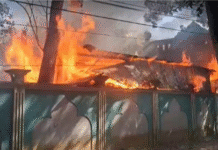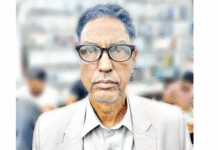How not to ‘Historicise’ 1971?

The newly established ‘Centre for Genocide Studies’ at the University of Dhaka seems very appropriately placed to conduct such research from an objective, scholarly perspective. Thus with great interest we welcomed the book “Historicizing 1971 Genocide: State versus Person” by Prof Imtiaz Ahmed, director of the CGS. A rather thin book at merely 4 chapters across 44 pages, it raises expectations of being a cosy read one can finish while sitting on the bus waiting for the traffic to clear. Yet, rather unfortunately, we come to the conclusion that the book is more annoying than being stuck in a traffic jam for five hours. Moreover, just like the harmful pollution encountered in a traffic jam, this book will pollute your own understanding of the history of 1971 through misinformation and misinterpretation.
To begin with, you might be intrigued by the word ‘historicising’, and wonder why the history of 1971 has to be interpreted as a conflict between the state and the person? We will learn more about that soon, but right from the first chapter the book comes through as a jargon-bag of postmodernist theory. You will be flooded with names like Foucault and Hegel and words such as hegemony, discourse, counter-discourse, subaltern, colonialism, semi-colonialism, dialectic, neurosis, and psychoneurosis. To our understanding, not only can such heavy-handedness alienate a lay reader from understanding the history presented in the book, it doesn’t seem necessary to understand such jargon or theories to understand the facts of 1971.
In short, inspired by postmodernist theory, the book tries to draw a contrast between ‘statist discourse’ and ‘personography’. The first means the analysis or understanding as directed by the state, while the second means the experiences of a person from their own perspective. The author claims that the two perspectives give rise to very different narratives of history; while in western practices the state is always the determining authority, writing history or conducting genocide trials from their own positions – the personal narratives of genocide victims are often ignored. The principal aim of the author seems to be bridging the gap between these two – while the state-conducted genocide trials should continue, the victims’ chronicles should not be ignored either.
A fair suggestion, but the author never fleshes out why there is necessarily a conflict, or how the proposed assimilation might be undertaken. Instead, the whole first chapter is spent in a postmodernist discussion of what history is, how history is written, what Rabindranath or Hegel have said about history, etc. Being a rather thin book with only four chapters, to spend a whole chapter on theorising about history while the task at hand is specifically analysing the history of 1971, seems to be a clear wastage.
The second chapter touches upon ‘statist discourse’, where the author criticises the Bangladesh government for ignoring the responsibility of pursuing the history of 1971. But, despite his criticism of the official discourse on 1971, the author never actually describes what the official narrative is. In addition, the author surprisingly ignores the well-known fact that there has never been a consistent official position on the war due to the political instability.
Amusingly, the author places most of the blame on Sheikh Mujib for the government’s failure to construct the history of 1971 and for letting the Pakistani war criminals and their local collaborators go – all while carefully avoiding the actual word Razakar. He also agonises over the controversy regarding the genocide death toll, saying that Mujib’s claim of 3 million war deaths is a ‘statistical nightmare’. In his opinion, “The discourse on the numbers was the most painful one; for it went on to quantify death with little or no attention to the person concerted.” He never gives Mujib any credit for the Liberation War; the only time he says something positive about him is while referring to the Mar 7 speech, but in much distorted context while justifying his own misinterpretation, which we’ll see later.
It is relevant to note that the author completely omits any mention of the political instability following Mujib’s assassination, when subsequent military rulers brought back war criminals, granted them citizenship, and even ministerial positions, thus never mentioning the real reasons for the lack of a coherent official position on 1971. For the author, it is enough to rest the majority of blame on Sheikh Mujib.
The third chapter is supposedly a discourse on the ‘persons’, but the author actually makes it a discourse on Dhaka University, focusing upon its glorious history, its contribution to the 1952 language movement and 1971 liberation movement, etc., so we wonder why it shouldn’t be called the DUist discourse instead?
Here the author moves aside the intellectuals and focuses on the subalterns, specifically the ordinary staff of the University of Dhaka, such as the gardeners, cooks or sweepers who were affected by the 1971 war despite not being active participants. The author wants to emphasise their sufferings despite their innocence, recommending interviews with them as an avenue for research and contrasting it with the experiences of students and teachers who were the ideological leaders of the movement. He further suggests that people who caused their sufferings should be prosecuted. These are valid claims, but trivial ones. For one, it is well known that despite being targeted categorically by the Razakars, the intellectuals were few in numbers and therefore the majority of victims were common men, women and children. But more importantly, the current government has already been doing exactly what is being recommended, through the war crimes tribunal by prosecuting the war criminals, where hundreds of common people have come forward as witnesses to share their accounts of personal suffering. And interviews of many victims, including Birangonas, have been published in official documents and as case studies conducted by researchers at many institutes. So it seems unnecessary to portray the common people’s case as conflicting with the governmental perspective.
In the last chapter, Epilogue, the author tries to strike a reconciliation through his contrived opposition of the state and the people. And just as the previous chapter was a sales pitch for Dhaka University, this chapter is a sales pitch for the proposition of a Genocide Centre. And it is obvious that he was successful in his pitch, because after this 2009 book a Genocide Centre was eventually established at Dhaka University with the author as its director. The ‘Background & Rationale’ section of its former website was even a near-perfect copy of this chapter. Here he invites the government to establish such a centre with the goal of ‘knowledge creation’, where they can conduct research and teaching on genocide, as well as having genocide tours and a genocide museum. Needless to say, his Dhaka University would be the best place for such an establishment, for reasons he presented earlier.
He suggests that such reconciliation between the state and the people can be done at four possible levels: person, group, national or international. Funnily enough, he recommends an emphasis on the last two levels, saying that an individual victim filing a case against a perpetrator would have difficulty gathering all the evidence as so much time has passed, while the state can start the prosecution and call all victims to appear as witnesses. As explained, this is a rather trivial statement and the government had already begun this procedure when the book was published. So it is completely unnecessary to embark on this circular, self-contradictory discourse throughout the book. First the author tries to paint a conflict between the narratives of the state and the people, despite Bangladesh never having a coherent official narrative in its past, then makes the trivial claims about ‘emphasising the individual people’, then calls for a reconciliation between the state and the people, and finally recommends the state take charge of the procedure to do something it is already doing.
Every year, thousands of low-quality books are published, ignored by readers and lost to oblivion, just as we ignore advertisement pamphlets handed to us on the footpath. Perhaps efforts to downplay Sheikh Mujib can also be ignored, because his great contributions do not need anyone’s certification. But ignoring this book would be a major mistake, because a careful reading shows how this work by the director of the Centre for Genocide Studies itself contains deliberate efforts of misinforming and misinterpreting facts about 1971, and we must question the rationality of having such academics at such important positions who may shape the very direction of research conducted at such institutions.
In general, the level of academic rigour in the book is abysmal. One can see the lack of sincerity when the author, despite being a proud member of the Dhaka University, mislabels a building of the Lalbagh Fort as the old campus of DU. He also uses a photo of the 1952 Language Movement to depict the raising of national flag at DU during the liberation movement. Two famous British philosophers, the father-son duo of James Mill and John Stuart Mill, are amalgamated in the discourse-saturated introduction to create a new persona for a photo, ‘James Stuart Mill’. He further mixes up the years and the book titles between the two. In most cases, checking his own cited sources would’ve identified these errors. To top it all off, he offers a photo of the Cambodian genocide with the annotation “Source: Internet”, making it rather evident that the level of academic rigor is similar to that of a high school student’s homework essay.
But the more serious offence, for which we must hold the author accountable, is the intentional misrepresentations of facts to suit his distorted discourse in taking the credit away from the Bangladesh state and its founder Sheikh Mujib. He strives to portray the Liberation War as an India-Pakistan war with India being in total charge of things without Bangladeshi representation, and with some adept surgery he is able to make it appear so to a lay reader.
In the second chapter he states that the Indian army reached the outskirts of Dhaka on Dec 14, 1971 and issued an ultimatum call of surrender to Pakistan. This is totally wrong, not only because of the true date being Dec 15, but also because this call was issued after the Pakistani army indicated their willingness to surrender. “Since you have indicated your desire to stop fighting…” is how the message begins, but the author intentionally excised that part in his quotation to make it appear that India forcefully initiated it.
Soon after that he claims “with the Indian control of the final phase of the liberation war, the nationalist struggle of Bangladesh was transformed into an exclusively Indo-Pakistan affair.”, and that “The surrender document, signed on 16 December, 1971, is a further proof of this”. While copying parts of the Instrument of Surrender, he quotes it as “The Pakistan Eastern Command agree to surrender all Pakistan Armed Forces in Bangla Desh to Lieutenant-General Jagjit Singh Aurora …”. From his cited source, however, one can see that the “…” part he omitted reads as “General Officer Commanding in Chief of Indian and Bangla Desh forces in the Eastern Theater”, and the signature of General Aurora below the document repeats it. So he intentionally omits all references to his own nation of Bangladesh from such an important document to improperly push his viewpoint.
With many such examples, the author’s tone in the book at times sounds quite similar to the author and genocide denier Sarmila Bose, which is disturbing when coming from the director of a Genocide Centre. He blames a lack of awareness about the genocide to the ‘statist discourse’ right from the beginning, starting with the Instrument of Surrender, childishly claiming that such a to-the-point official document should have contained a discussion of the genocide, its perpetrators, the extent and the repercussions, but it didn’t because then Pakistan would have backed off from the surrender.
Then he blames Sheikh Mujib repeatedly for mishandling the official approach to the genocide, saying “the death figure of three million in nine months became a statistical nightmare and the officers in charge had no foreknowledge or even the means to substantiate all the killings”, and “The death figures in a period of only nine months and incidentally accepted by both sides of the conflicting parties run in hundreds and thousands.” Oddly enough for an academic, he never provides any references to these outlandish claims. And as any person aware of the genocide death toll would know, there is certainly no agreement in the accepted death figures between Bangladesh and Pakistan – just like Prof Ahmed, Pakistan’s Hamoodur Rahman Commission report puts it at 26,000, while pro-Pakistani authors like Sarmila Bose put it at 50-100,000; in contrast Bangladesh’s official count is 3 million, and independent researchers such as R J Rummel suggest 1.5 million.
Regarding the numbers, Prof. Ahmed is equally adept as Sarmila Bose and other pro-Pakistani authors at playing the indirect citation game to create a falsely heightened sense of credibility – they mask a blatantly baseless or pro-Pakistani citation by citing someone else who refers to that original citation. Like them, he states that a large number of Biharis were also violently killed by the Bengalis, between 15-50,000, and cites Sumit Sen at International Journal of Refugee Law. It’s only when one looks up this article that one can see that this number comes from none other than the Govt of Pakistan, in a 1971 White Paper.
But while one may easily look up the facts, it is harder for a lay reader to pursue the theories of genocide, and that is where the book is even more harmful. Just like Sarmila Bose, the author claims that the massacre by Pakistani forces does not constitute as genocide according to any official definition, because it was not perpetrated for religion, race, ethnicity, language, class, or ideology. Weirdly, he says ethnicity cannot be a reason “because inter-cultural interactions, including inter-marriages, were common between East and West Pakistanis.” That is a baseless argument without presenting data on intermarriages in erstwhile Pakistan, and from such a perspective the Nazi holocaust wouldn’t count as genocide either, because inter-marriages between ‘Aryans’ and ‘non-Aryan’ ethnicities were so high that the Nazi government had to enact laws trying to ban it to preserve ‘purity’.
We can revert back to other notable scholars, such as Adam Jones in ‘Genocide: A Comprehensive Introduction’, RJ Rummel in ‘Death by Government’, or Nayanika Mookherjee, who all demonstrate how a hatred for Bengali identity, ethnicity and culture was the driving force for this genocide. More importantly, right after the genocide in 1972 the International Commission of Jurists published a legal report explaining “In our view there is a strong prima facie case that the crime of genocide was committed”. So unless Prof Ahmed is a better legal scholar than the ICJ and others on genocide, his arguments don’t hold water. It appears that he is rejecting the current definitions of genocide as inapplicable because he wants to extend and re-define genocide, understandably at his proposed genocide research centre.
As a final example of the author’s masterful mishandling of truth, consider his statement that Sheikh Mujib cleverly ended his Mar 7 speech with a shout of “Joy Pakistan”. It is a commonly held myth, despite evidence to the contrary, and the only ‘evidence’ offered by proponents of this myth is that they ‘heard it themselves’. Similarly, he claims, “The author was present at the Race Course, now Suhrawardy Udyan, on Mar 7, 1971 and therefore heard the entire speech in person.” He warns that some people however dispute this literal truth, and provides two references to back himself up. Ironically, both his references quote it as “Jiye Pakistan” and not “Joy Pakistan”, despite all three claiming to hear it themselves.
Notably, he refers specifically to the first edition of Habibur Rahman’s ‘Bangladesher Tarikh’, misidentifying it as ‘Bangladesher Son o Tarikh’ in his citation. Why specifically the first edition? Because Prof Ahmed knows that Habibur Rahman released a 2nd edition in 2001 mentioning the need for corrections, where he deleted his claim of hearing “Jiye Pakistan”.
The same happens with Shamsur Rahman’s ‘Kaler Dhuloy Lekha’ in which the author claimed to hear “Jiye Pakistan” at the end of the speech live on radio. When others pointed out that Pakistan had banned transmission of the speech on radio that day, he issued a public apology and retraction in a newspaper, many years before Prof Ahmed’s book.
So despite knowing that both his cited sources later retracted their claims, he keeps citing them to lend some air of support to his unsubstantiated assertion of putting “Joy Pakistan” in Sheikh Mujib’s mouth.
In summary, we urge any readers of this book to see through the superficial veneer of scholarship to notice the blatant disregard for academic norms, denial of the theories and estimates of Bangladesh’s genocide, and a strong intention of misrepresenting facts to suit a biased personal ideology. And yet, this book was evidently so successful as a sales pitch so that a new genocide centre was established at Dhaka University with its author at the helm. Judging by its quality, one has to worry whether baseless theoretical exercises such as ‘discourse reconciliation between the state and the person’ or ‘re-defining genocide’ would suck up important funding at the centre that could’ve been used at more pertinent research or even as compensation to genocide victims. Even more worrying is the idea that with such academics at important positions in the centre, a national institute may publish further distortions of facts and inappropriate vilification of official policies.
Historicizing 1971 Genocide
State versus Person
Imtiaz Ahmed
The University Press Limited , 2009.









